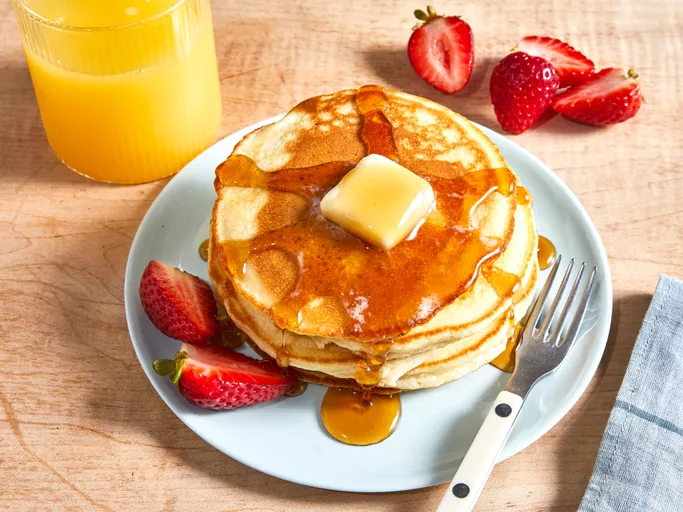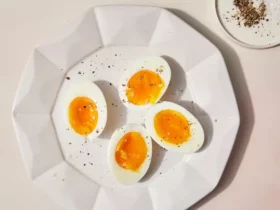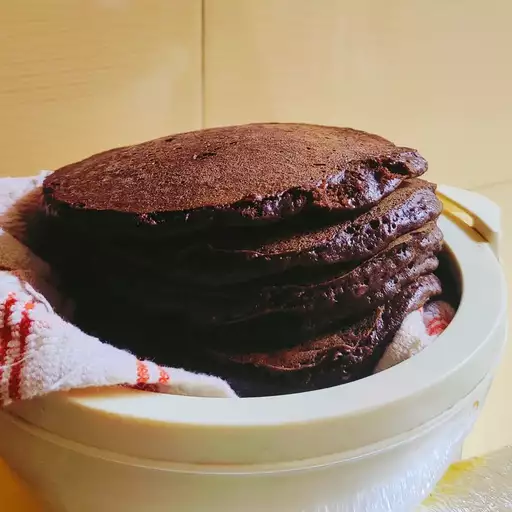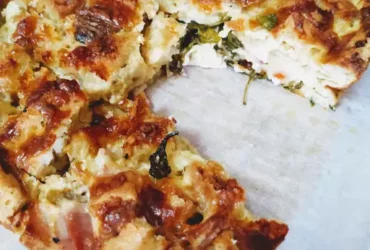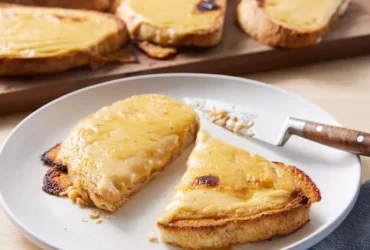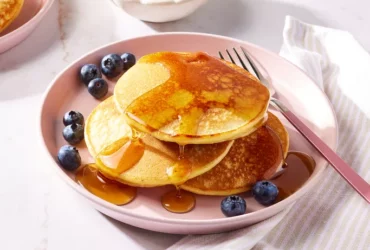Ingredients and Tools
Simple Pancakes Requirements
The success of making simple pancakes depends largely on two critical elements: ingredients and tools. Here’s a comprehensive overview of what you’ll need to get started.
Ingredients:
- You’ll require the following basic pantry items to prepare delicious pancakes:
- 1 cup all-purpose flour – This is your base ingredient, which provides structure and texture to the pancake.
- 2 tablespoons sugar – A small amount of sugar adds a touch of sweetness, but feel free to adjust or omit it according to your taste preferences.
- 2 teaspoons baking powder – Baking powder is essential for the pancake’s rise and texture. Make sure it’s fresh for optimal results.
- 1/4 teaspoon salt – A pinch of salt enhances flavors and helps balance sweetness.
- 1 cup milk – Use whole, low-fat or skim milk according to your dietary requirements. The type of milk affects the pancake’s richness and texture.
- 1 large egg – Fresh eggs provide moisture, protein, and structure to the pancakes.
- 2 tablespoons melted butter or oil – You can use either butter or a neutral-tasting oil like canola or coconut oil for greasing your pan and adding flavor.
Tools:
Here are the tools you’ll need to make perfect pancakes:
- A medium bowl for whisking dry ingredients
- A large mixing bowl for combining wet ingredients and folding in the dry mixture
- A non-stick skillet, griddle or pan – Choose a pan with a smooth surface to prevent sticking.
- Spatula – Use a heat-resistant spatula to handle the pancake batter and flip your pancakes.
- Measuring cups and spoons – Accurate measurements are crucial for achieving consistent results.
- Electric mixer (optional) – If you prefer not to whisk or mix ingredients manually, an electric mixer can simplify the process.
Baking powder 1 teaspoon
Baking powder is a crucial ingredient in pancake recipes, including this easy pancakes recipe. It serves as a leavening agent that releases carbon dioxide gas when it comes into contact with liquid ingredients, causing the batter to rise and giving pancakes their light and fluffy texture.
When using baking powder in cooking, it’s essential to note that the amount required can vary depending on the recipe and personal preference. In this particular easy pancakes recipe, we’re calling for 1 teaspoon of baking powder per batch of pancake batter.
The role of baking powder becomes especially important when you consider the chemical reaction that occurs between the baking powder and acidic ingredients in the recipe, such as buttermilk or yogurt. This reaction helps to break down the baking powder into its active components, which then release carbon dioxide gas and cause the pancake batter to rise.
It’s also worth noting that baking powder is a blend of sodium bicarbonate (baking soda) and an acid, usually cream of tartar, along with a moisture absorber such as starch or cornstarch. When mixed with liquid ingredients, the acid in the baking powder reacts with the sodium bicarbonate to produce carbon dioxide gas and water.
When using baking powder, it’s essential to follow the recipe carefully, especially when it comes to the ratio of dry ingredients to leavening agents. Using too much baking powder can result in a soapy or metallic taste in your pancakes, while using too little may not provide enough lift and texture.
To get the best results with baking powder, make sure to use fresh ingredients and store your baking powder properly in an airtight container to maintain its potency. You should also ensure that you’re measuring the baking powder accurately, as small variations can affect the final outcome of your pancake recipe.
Flour 1 cup
All-purpose flour serves as a fundamental component in the preparation of various baked goods, including pancakes. The quantity needed for the recipe is 1 cup.
When selecting a flour, it’s essential to choose an all-purpose variety that contains both hard and soft wheat. This type of flour provides the right balance of strength and tenderness, making it ideal for producing light and fluffy pancakes.
Some other types of flour that may be used in pancake recipes include whole wheat flour or oat flour. However, these options might affect the flavor and texture of the final product.
Pan baked goods like pancakes can benefit from having a bit of extra gluten in the dough. This is often achieved through the use of bread flour or by adding vital wheat gluten to an all-purpose flour mixture. However, for this particular recipe, all-purpose flour is sufficient.
Tools and Equipment
- A medium-sized bowl for whisking dry ingredients
- A separate large bowl for beating wet ingredients
- A whisk or stand mixer to cream butter with sugar, followed by incorporating eggs and milk
- A rubber spatula for gently folding in the flour mixture into the wet ingredients
- A heat-resistant non-stick skillet or griddle over medium heat for cooking pancakes
- A measuring cup and spoon set for accurate measurements
- A plate for serving freshly cooked pancakes
Eggs 1 large egg
For making delicious pancakes using eggs as an ingredient, you’ll need to have the following tools and ingredients on hand:
Ingredients
- Eggs: 1 large egg
- All-purpose flour: 1 cup
- Baking powder: 2 teaspoons
- Salt: 1/4 teaspoon
- 1 tablespoon (optional)
- Milk: 3/4 cup
- <b.butter, melted:<=”” b=””> 2 tablespoons</b.butter,>
- Vegetable oil or butter for greasing the pan
Tools
- Medium bowl for whisking dry ingredients
- Large bowl for whisking wet ingredients and combining them with the dry ingredients
- Whisk for mixing eggs, milk, melted butter, and sugar (if using)
- Measuring cups and spoons for accurately measuring out ingredients
- Spatula or wooden spoon for gently folding the wet and dry mixtures together
- Cooking pan (preferably non-stick) for making pancakes
- Non-stick cooking spray or a brush with melted butter to grease the pan between batches of pancakes
Note: These tools and ingredients can be easily found in most supermarkets, making it simple to get started on your delicious pancake-making journey!
Milk 1/2 cup
The key to making delicious pancakes lies not only in the recipe, but also in the quality and quantity of the ingredients used. For our easy pancakes recipe, we will need:
- Flour: 1 cup all-purpose flour serves as the base for our pancake batter.
- Sugar: 2 tablespoons granulated sugar adds a touch of sweetness to our pancakes.
- Eggs: 2 large eggs provide moisture, richness, and structure to our pancakes.
- Milk: As specified in the task, we will need 1/2 cup milk, which adds creaminess and tenderness to our pancakes.
- Butter or Oil: We will use 2 tablespoons melted butter or vegetable oil to add flavor and prevent sticking.
- Baking Powder: 2 teaspoons baking powder helps our pancakes rise and gives them a light texture.
- Salt: A pinch of salt enhances the flavors in our pancake batter.
For the tools needed to make these delicious pancakes, we will require:
- A medium-sized bowl for whisking the dry ingredients together.
- A separate bowl for whisking the wet ingredients together.
- A measuring cup for accurately measuring out our ingredients.
- A wooden spoon or silicone spatula for gently folding the wet and dry ingredients together.
- An electric mixer (optional) to make the process easier, especially if you’re dealing with a larger batch of batter.
- A non-stick pan or griddle for cooking our pancakes over medium heat.
Having these ingredients and tools readily available will ensure that your easy pancakes recipe turns out fluffy, delicious, and perfect for any meal or occasion!
Honey or sugar (optional)
The foundation of any great pancake recipe lies in its ingredients, and for a delicious and fluffy treat, you’ll want to focus on using high-quality staples. Start by gathering these essential items:
- 1 cup all-purpose flour: This is the base ingredient that provides structure and texture to your pancakes.
- 2 tablespoons sugar (or 1-2 teaspoons honey): Adding a touch of sweetness will balance out the flavors, but feel free to omit if you prefer a savory option.
- 2 teaspoons baking powder: This leavening agent is responsible for making your pancakes light and fluffy.
- 1/4 teaspoon salt: A pinch of salt enhances the overall flavor and helps bring out the sweetness in the other ingredients.
- 1 cup milk (or buttermilk): Choose a dairy or non-dairy option that suits your dietary preferences; the milk adds moisture and tenderness to the pancakes.
- 1 large egg: This binding agent holds everything together, providing a smooth and even texture.
- 2 tablespoons melted butter (or oil): Add this to enhance flavor and create a tender crumb.
In terms of tools, you’ll need:
- A mixing bowl: Choose one that’s large enough for all the ingredients; stainless steel or glass bowls work well for their durability and ease of cleaning.
- Measuring cups (dry and liquid): For precise measurements and accurate proportions.
- Measuring spoons: To add a pinch of salt, a dash of sugar, and so on.
- A whisk or electric mixer: For beating the egg, mixing the batter, and ensuring all the ingredients are well combined.
- A non-stick skillet (or griddle): This is where you’ll cook your pancakes to perfection. Make sure it’s clean and seasoned before use for a smooth release of each pancake.
- Now that we have our ingredients and tools ready, let’s move on to the next steps in making this Easy Pancakes Recipe!
Selecting the Right Equipment
The success of easy pancakes largely depends on the ingredients and tools used. The following are some essential items that one should consider.
Ingredients
- Milk: Fresh milk is ideal for making fluffy pancakes, but you can substitute it with water or a non-dairy alternative if needed. For this recipe, use about 1 cup of milk.
- Large Eggs: These will add moisture and richness to the batter, so make sure they are fresh before adding them to the mixture.
- All-purpose Flour: This is a key ingredient that provides structure and texture to the pancakes. You’ll need about 1 cup of all-purpose flour for this recipe.
- Sugar: A little sugar adds flavor to the batter, but be careful not to use too much as it can make the pancakes sweet and unappetizing.
- Baking Powder: This leavening agent helps the pancakes rise when cooked. Use about 1-2 teaspoons for this recipe.
- Salt: Add a pinch of salt to enhance the flavor, but avoid using too much as it can overpower the other ingredients.
- Melted Butter or Oil: This adds moisture and helps bind the batter together. Use about 1-2 tablespoons for this recipe.
Tools
- Non-stick Skillet or Frying Pan: A non-stick skillet is ideal for making pancakes as it prevents them from sticking and makes cleanup easier. If you don’t have a non-stick skillet, use a regular frying pan but be sure to grease it with butter or oil.
- Measuring Cups and Spoons: Accurate measurements are crucial when making easy pancakes. Use measuring cups and spoons for precise measurements.
- Electric Whisk: An electric whisk is ideal for mixing the batter quickly and easily, but you can use a manual whisk if needed.
- Bowl: You’ll need a large bowl to mix the ingredients together. A stainless steel or glass bowl works best.
- Plate or Tray: For serving pancakes, it’s essential to have a clean plate or tray ready for each pancake as soon as they’re cooked.
The quality of your ingredients and tools can affect the taste, texture, and overall appearance of your easy pancakes. Invest in good-quality equipment and fresh ingredients to achieve the best results.
Nonstick pan or griddle
The key to making delicious pancakes lies in the ingredients and tools used. Here are some essential items you’ll need for this recipe.
Ingredients:
- 1 1/2 cups all-purpose flour
- 3 1/2 teaspoons baking powder
- 1 teaspoon salt
- 1 cup granulated sugar
- 1 cup milk
- 2 large eggs
- 2 tablespoons unsalted butter, melted
- Flavorings such as vanilla extract or cinnamon (optional)
Tools:
- A nonstick pan or griddle with a surface area of at least 12 inches in diameter.
- A heat-resistant spatula for flipping pancakes.
- A measuring cup and spoons for accurately measuring ingredients.
- An electric mixer or whisk for mixing the batter (optional).
- A plate or tray for serving cooked pancakes.
For a nonstick pan, make sure to choose one with a durable non-stick coating that can withstand high heat. This will ensure your pancakes don’t stick and are easy to flip and remove.
Nonstick pans or griddles are ideal for making pancakes because they distribute heat evenly and prevent the formation of hotspots, which can burn your pancakes. You can also use a cast-iron skillet if you have one, but make sure it’s well-seasoned before using it for this recipe.
If you don’t have a nonstick pan or griddle, you can also use a stainless steel or aluminum pan with a bit of oil or butter to prevent sticking. However, keep in mind that these pans may not distribute heat as evenly and your pancakes might cook more unevenly.
Spoon for measuring dry ingredients
To make delicious pancakes, you’ll need to start with the right ingredients. The ingredients list may vary depending on the recipe, but for a classic pancake recipe, you’ll typically need:
- 2 cups all-purpose flour
- 4 teaspoons sugar
- 2 teaspoons baking powder
- 1/4 teaspoon salt
- 1 cup milk
- 1 large egg
- 2 tablespoons melted butter or oil
- Flavorings such as vanilla extract (optional)
A good quality spoon for measuring dry ingredients is essential in the kitchen. When it comes to measuring dry ingredients like flour, sugar, and baking powder, a digital spoon with measurements is highly recommended.
Here’s why:
Dry ingredients can be tricky to measure accurately, especially when using a traditional spoon. Even small variations in measurement can affect the outcome of your recipe. A digital spoon ensures that you get the precise amount every time.
A good quality digital spoon for measuring dry ingredients should have the following features:
- Accurate measurements: Ensure the spoon has clear and easy-to-read markings on the handle and body, making it simple to measure out exact amounts.
- Durable construction: Look for a spoon made from durable materials that can withstand daily use and cleaning.
- Ergonomic design: A comfortable grip and balanced weight make it easier to hold and maneuver the spoon, reducing fatigue and strain.
Preparation and Cooking
Mixing Dry Ingredients
Mixing dry ingredients is an essential step in preparing for a delicious batch of pancakes. To start, you will need to gather all the necessary dry ingredients, which typically include flour, sugar, baking powder, and salt.
The type and quality of flour used can greatly affect the texture and flavor of your pancakes. All-purpose flour is a popular choice, but you can also use whole wheat or other types of flour to add more nutrients and depth to your pancake batter.
Sugar adds a touch of sweetness to your pancakes, but be careful not to overdo it, as too much sugar can lead to burnt or overly dark pancakes. The amount of sugar you use will depend on your personal preference and the type of recipe you are following.
Baking powder is a leavening agent that helps your pancakes rise and gives them a light and fluffy texture. Make sure to use fresh baking powder, as old or stale baking powder can affect the texture and flavor of your pancakes.
Salt adds depth and balance to your pancakes, but be careful not to overdo it, as too much salt can make your pancakes taste bitter. Use a moderate amount of salt that complets the flavors in your recipe.
To mix the dry ingredients, start by sifting or whisking them together in a large bowl until they are well combined and evenly distributed. You can use a fine-mesh sieve to sift the ingredients, or simply whisk them together with a wire whisk.
Once you have mixed your dry ingredients, set them aside until you are ready to combine them with your wet ingredients. Make sure to store any leftover dry ingredients in an airtight container to keep them fresh and prevent them from absorbing moisture from the air.
In a medium bowl, whisk together baking powder and flour
To prepare and cook delicious pancakes using our easy pancake recipe, follow these steps:
Preparation
Gather all the necessary ingredients to ensure that your process runs smoothly.
Here are the required ingredients for this recipe:
- 1 cup of milk (whole, skim or 2%)
- 1 large egg
- 2 tablespoons of melted butter or oil
- 2 teaspoons of sugar (or to taste)
- 1 teaspoon of vanilla extract (optional)
- 1 3/4 cups of all-purpose flour
- 2 teaspoons of baking powder
- A pinch of salt (about 1/8 teaspoon)
To combine the dry ingredients:
- In a medium bowl, whisk together baking powder and flour. This is to prevent lumps from forming when you mix the wet and dry ingredients.
- Set this mixture aside for now.
Cooking the Pancakes
Around 20-30 minutes before cooking, preheat a non-stick skillet or griddle over medium heat. You want to ensure that your cooktop is evenly heated and ready for the pancakes.
- In a large bowl, whisk together milk, egg, melted butter, sugar, and vanilla extract (if using). Make sure there are no lumps in this mixture.
- Add the dry ingredients to the wet mixture and mix until just combined. The batter should still be slightly lumpy.
- When your skillet or griddle is ready, drop the batter by 1/4 cupfuls onto the cooktop. You may need to spread out the batter slightly with a spatula.
- Cook for about 2-3 minutes or until bubbles form on the surface of the pancake and the edges start to dry.
- Flip over and cook for another minute, until golden brown. Repeat this process with remaining batter.
Serve your pancakes warm with your favorite toppings such as butter, maple syrup, fresh fruit, or whipped cream!
Combining Wet and Dry Ingredients
The key to making perfect pancakes lies in the preparation and cooking process, particularly when it comes to combining wet and dry ingredients. To achieve fluffy and delicious pancakes, follow these steps:
Preparing Wet Ingredients
Before starting to combine the wet and dry ingredients, ensure you have all your wet ingredients ready.
- Milk: Use fresh milk for best results. You can use any type of milk, such as whole, 2%, skim, or non-dairy alternatives like almond or soy milk.
- Eggs: Fresh eggs are crucial in pancake-making. Crack them open and whisk them together until they’re fully incorporated with the other wet ingredients.
- Butter or Oil: Melt your butter or heat your oil until it’s warm, then let it cool slightly before adding it to the wet ingredients.
Mixing Wet Ingredients
Once you have all your wet ingredients ready, mix them together in a large bowl:
- Add milk to the bowl first. Whisk gently until it’s fully incorporated with the eggs.
- Then add melted butter or oil. Continue whisking until everything is well combined and smooth.
Preparing Dry Ingredients
In another bowl, prepare your dry ingredients:
- Pancreas Flour: Use all-purpose flour as a substitute if you don’t have pancake mix or don’t have self-raising flour.
- Baking Powder: Fresh baking powder is essential to making light and fluffy pancakes. Check the expiration date before using it.
- Sugar or Sweetener (optional): If you’re using sugar, use granulated sugar for best results. You can also use a sweetener like honey or maple syrup if preferred.
Mixing Wet and Dry Ingredients
Now it’s time to combine your wet and dry ingredients:
- Pour the dry ingredients into the bowl with the wet ingredients. Mix gently until everything is well combined, making sure not to overmix.
- Some lumps may still appear; this is okay. Overmixing will result in dense pancakes.
Resting the Batter
To ensure your pancakes are fluffy and tender, it’s essential to let the batter rest:
- Allow the batter to rest for 10-15 minutes before cooking. This allows the flour to absorb the liquid ingredients.
- This step also helps the baking powder to activate, resulting in lighter pancakes.
Cooking Pancakes
Once your batter has rested, it’s time to cook:
- Preheat a non-stick pan or griddle over medium heat.
- Scoop 1/4 cup of the batter onto the preheated pan.
- Cook for 2-3 minutes until bubbles appear on the surface. Flip and cook for another minute, until golden brown.
Crack in eggs; pour milk on top of the eggs
To prepare easy pancakes, start by cracking 2-3 large eggs into a bowl. The number of eggs may vary depending on your desired pancake thickness and serving size.
Next, pour about 1/2 cup to 1 cup of milk over the cracked eggs in the bowl. You can use any type of milk you prefer such as whole, skim, or a non-dairy alternative like almond or soy milk.
Milk is added to help thin out the egg mixture and create a smooth consistency perfect for pancakes. The amount of milk may vary depending on how thick or runny you want your batter to be.
Tips and Variations
Cooking Tips
To achieve fluffy and delicious pancakes, it’s essential to understand the importance of proper mixing, resting, and cooking techniques.
Tips for Making Perfect Pancakes
Here are some valuable tips to help you create a mouth-watering batch of pancakes:
- Use buttermilk: Buttermilk adds moisture and tenderness to your pancakes. If you don’t have buttermilk, you can make a substitute by mixing 1 cup of milk with 1 tablespoon of white vinegar or lemon juice. Let it sit for 5-10 minutes before using.
- Don’t overmix the batter: Overmixing will result in tough and dense pancakes. Stop mixing as soon as all ingredients are combined, and let the mixture rest for 10-15 minutes to allow the flour to absorb liquid.
- Use room temperature eggs: Cold eggs can cause the butter to solidify and the batter to become lumpy. Take your eggs out of the fridge about an hour before mixing to bring them to room temperature.
- Add leavening agents correctly: Too much baking powder or baking soda can lead to a soapy or metallic taste in your pancakes. Use 1 teaspoon of each, and make sure they are fresh.
- Don’t overfill the pan: Pour the right amount of batter onto the pan, leaving about 1 inch (2.5 cm) around the edges for expansion during cooking.
Variations and Add-Ins
Pancakes can be made in various flavors by incorporating different mix-ins or altering the basic recipe:
- Blueberries: Fold in 1/4 cup of fresh or frozen blueberries into the batter for a sweet and fruity twist.
- Banana: Mash 1 ripe banana and fold it into the batter for added moisture and flavor.
- Cinnamon sugar: Sprinkle a pinch of cinnamon over the pancakes before serving for an extra layer of warmth and sweetness.
- Chocolate chips: Add 1/4 cup of semisweet chocolate chips to create a decadent treat.
Cooking Tips
Once you have your perfect pancake batter, it’s time to cook them:
- Use a non-stick pan: Grease the pan with butter or cooking spray and ensure it reaches medium heat (around 325°F/165°C) before pouring in the batter.
- Flip at the right moment: Once bubbles form on top and the edges start to curl, flip the pancake. Cook for another minute before flipping back onto a serving plate.
Melt a little butter or oil before adding batter to prevent sticking.
Melt a little butter or oil before adding batter to prevent sticking.
This tip is crucial when making pancakes, especially if you’re using a non-stick pan. The melted fat will create a barrier between the pan and the pancake mixture, allowing it to cook evenly and preventing it from sticking or burning.
However, be careful not to overdo it with the butter or oil, as this can make your pancakes greasy and unappetizing. A small amount should suffice – just enough to coat the bottom of the pan lightly.
Another variation you could try is adding flavorings to the melted fat before cooking the pancakes. For example, you could add a sprinkle of cinnamon or nutmeg for extra depth of flavor, or use garlic oil for a savory twist.
Some other variations on this technique include using different types of fat, such as coconut oil or avocado oil, which have distinct flavors that can enhance your pancakes. You could also try using infused oils, like truffle oil or chili oil, to give your pancakes an extra kick.
You could even experiment with adding a little bit of liquid to the melted fat before cooking the pancake mixture – this can help create a fluffier and lighter texture. Some options include milk, cream, or even water, depending on how rich you want your pancakes to be.
Experiment with Add-ins
When it comes to making delicious pancakes, there are countless ways to mix things up and add a personal touch. One way to do this is by experimenting with different types of add-ins that can enhance both the taste and texture of your pancakes.
Some popular add-ins include fresh or dried fruits such as blueberries, strawberries, bananas, or cranberries. Simply chop or puree these fruits and fold them into the batter for added flavor and nutrition.
Nuts are another great option to consider. Chopped almonds, walnuts, pecans, or hazelnuts can add a satisfying crunch to your pancakes. You can also try using different types of nut butters such as peanut butter or almond butter for added creaminess.
Cocoa nibs or chocolate chips can give your pancakes a rich and decadent flavor. Simply fold these into the batter and cook as usual for a delicious treat.
Other options include shredded coconut, cinnamon, nutmeg, or even espresso powder to create a mocha-flavored pancake. The possibilities are endless!
In terms of tips, it’s essential to remember that add-ins can affect the overall texture of your pancakes. For example, if you’re using nuts or seeds, be sure to fold them in gently to avoid overmixing the batter.
Additionally, some add-ins may require adjustments to the cooking time and temperature. For instance, if you’re using a lot of fruit, you may need to cook your pancakes for an extra minute or two to ensure they’re cooked through.
In terms of variations on the classic pancake recipe, consider trying different types of flour such as whole wheat, oat, or almond flour for added nutrition and flavor. You can also experiment with using buttermilk, sour cream, or yogurt to create a tangy and creamy pancake.
Don’t be afraid to get creative and try new combinations of add-ins. With practice and experimentation, you’ll develop your own unique recipe that suits your tastes and preferences.
Banana, chocolate chips, nuts for added flavor and texture
Adding a variety of ingredients to your pancakes can take them from simple to spectacular. One popular combination is bananas, chocolate chips, and nuts – each adding its own unique flavor and texture to create a delicious twist on traditional pancakes.
Bananas add natural sweetness and moisture to the batter, while also contributing a subtle banana flavor that pairs well with the richness of chocolate. To incorporate bananas into your pancake mix, simply mash one or two ripe bananas and fold them into the wet ingredients before adding the dry ingredients.
For an added depth of flavor and crunchy texture, chocolate chips are a great addition to this combination. You can use either dark, milk, or white chocolate chips – each variety will give your pancakes a distinct taste experience. Simply stir in 1/2 cup to 1 cup of chocolate chips into the batter after folding in the wet ingredients.
Nuts also add a delightful texture and flavor contrast to these banana-chocolate pancakes. Try using chopped nuts like walnuts, almonds, or pecans for added crunch. You can either fold them into the batter with the chocolate chips or sprinkle them on top of the pancakes before serving – both ways will give you a delicious nutty experience.
When choosing nuts, consider their flavor profile and how it might complement the banana and chocolate. For example, walnuts have a strong, earthy flavor that pairs well with the sweetness of bananas, while almonds have a mild, nutty flavor that works nicely with milk chocolate chips.
Don’t be afraid to get creative with your toppings – you can also use fresh fruit like blueberries or strawberries to create a sweet and tangy combination. Simply fold the fruit into the batter or top the pancakes with fresh berries after cooking.
Remember, the beauty of pancake recipes is that they’re highly customizable. Feel free to experiment with different combinations of ingredients to find your perfect match – and have fun with it!
- Best Datanyze Alternatives for 2025 - April 24, 2025
- Best Hunter.io Alternatives for 2025 - April 22, 2025
- Best Lead411 Alternatives for 2025 - April 22, 2025

